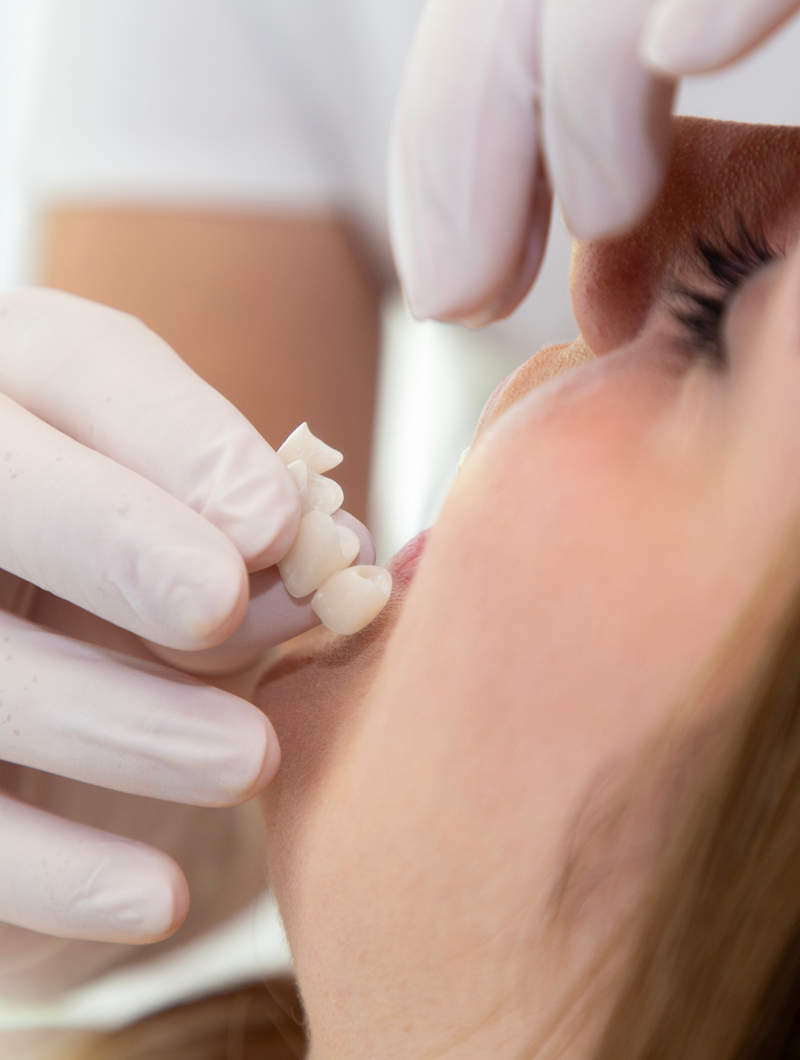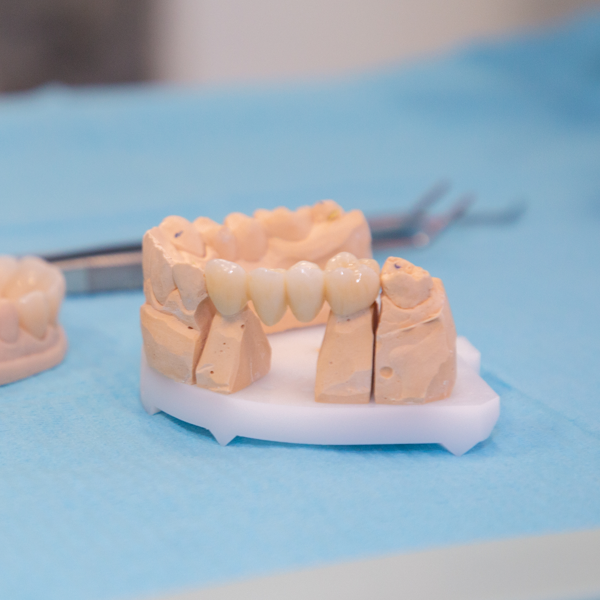Dental Bridge
Dental bridges are a long-term solution for replacing lost teeth, connecting the remaining teeth to ensure the functionality and aesthetics of your smile.


What is a dental bridge and why is it used?
A dental bridge is a fixed prosthetic replacement that serves to replace one or more missing teeth. Bridges are used to connect adjacent teeth – which serve as abutments – to artificial teeth that replace the missing teeth. This treatment restores chewing ability, improves the appearance of the smile, and prevents the remaining teeth from moving, which can cause additional dental problems.
Dental bridges are made of high-quality materials such as zirconia ceramic, metal ceramic, or all-ceramic, ensuring a natural appearance and durability. Although they are placed on existing teeth, the procedure is completely painless and can be done in just a few visits to the dentist.
Who is an ideal candidate for a dental bridge?
Dental bridges are an ideal solution for people who have lost one or more teeth and do not want or cannot use implants. Bridges are also recommended for those who want to restore the functionality of their bite, improve aesthetics, and prevent further dental problems caused by gaps in the oral cavity.
What are the benefits of dental bridges?
- Aesthetics – dental bridges are made to match the natural appearance of your teeth, with the goal of creating a seamless transition between natural and artificial teeth.
- Functionality – they restore your ability to chew and speak, as well as stability to your bite, improving your daily functioning.
- Longevity – with proper care, dental bridges can last for more than 10 years.
- Preventive – they prevent the movement of remaining teeth, which can cause bite problems and additional dental complications.
What are the types of dental bridges?
Dental bridge on natural teeth
A dental bridge on natural teeth is a fixed prosthetic solution in which natural teeth serve as bridge supports. This form of dental bridge is used when one or more teeth need to be replaced, and the adjacent teeth are healthy enough to support the bridge.
To place a bridge on natural teeth, the adjacent teeth need to be ground down to create space for the bridge to be fixed. After the grounding, an impression of the tooth is taken to create the appropriate dental crowns. Depending on your wishes and needs, the bridge can be made of metal-ceramic, zirconia-ceramic or full zirconia material, according to the desired appearance and strength.
A dental bridge on natural teeth usually consists of at least three crowns that are connected to each other into a single unit.
Dental bridge on implants
A dental bridge on implants allows the replacement of one or more lost teeth without the need to grind down adjacent teeth. Instead of using natural teeth as abutments, this bridge is attached to dental implants that serve as artificial tooth roots.
Installing a bridge on implants is an excellent option for patients with extensive tooth loss, especially in the back of the jaw – where it is often necessary to replace several molars. This approach ensures a completely natural appearance and high functionality, as implants provide strength that is similar to natural tooth structure.
We use metal-ceramic, zirconia-ceramic or full zirconia materials to create this type of bridge, depending on the patient’s preferences and the specifics of the case. Implant bridges are ideal for patients who want solutions without the need to grind healthy teeth, but with long-lasting and stable replacement function.
If the patient has a completely edentulous jaw, we recommend methods such as All-on-four or All-on-six, which allow for complete tooth replacement on four or six implants – which form a solid and stable foundation for the dental bridge. These methods also bring high aesthetic value, safety and longevity.
What does the installation of dental bridges look like?
Frequently asked questions
How to maintain a dental bridge and how long does it last?
Dental bridges can last more than 10 years, but with proper care and regular check-ups at the dentist. Maintaining a bridge includes regular brushing and cleaning between the bridge and neighboring teeth using special brushes or dental floss. Avoiding hard foods – such as chestnuts or ice – additionally helps to preserve the integrity of the bridge. Zirconia ceramic and metal dental bridges are extremely durable, but with regular maintenance they can last even longer!
Can a dental bridge be replaced if it becomes damaged?
Yes, dental bridges can be replaced if they become damaged or worn out. If you notice any signs of damage to the bridge, such as cracking, damage or loosening, it is important to consult a dentist as soon as possible. Depending on the type of damage, the dentist may decide to repair the bridge or make a new one. Early detection of the problem can prevent more serious damage and allow for timely intervention.

Dental bridges are an excellent solution for patients who have lost one or more teeth, as they allow the return of functionality and aesthetics of the smile. By using the most modern materials such as zirconia ceramics and metal-ceramics, we can achieve a natural look and long-lasting results. Placing a bridge improves aesthetics and restores normal chewing ability, which is crucial for overall health. In any case, our goal is to ensure comfort, functionality and a high quality of life for each patient.
Matea Sipina Surać, dr. med. dent.